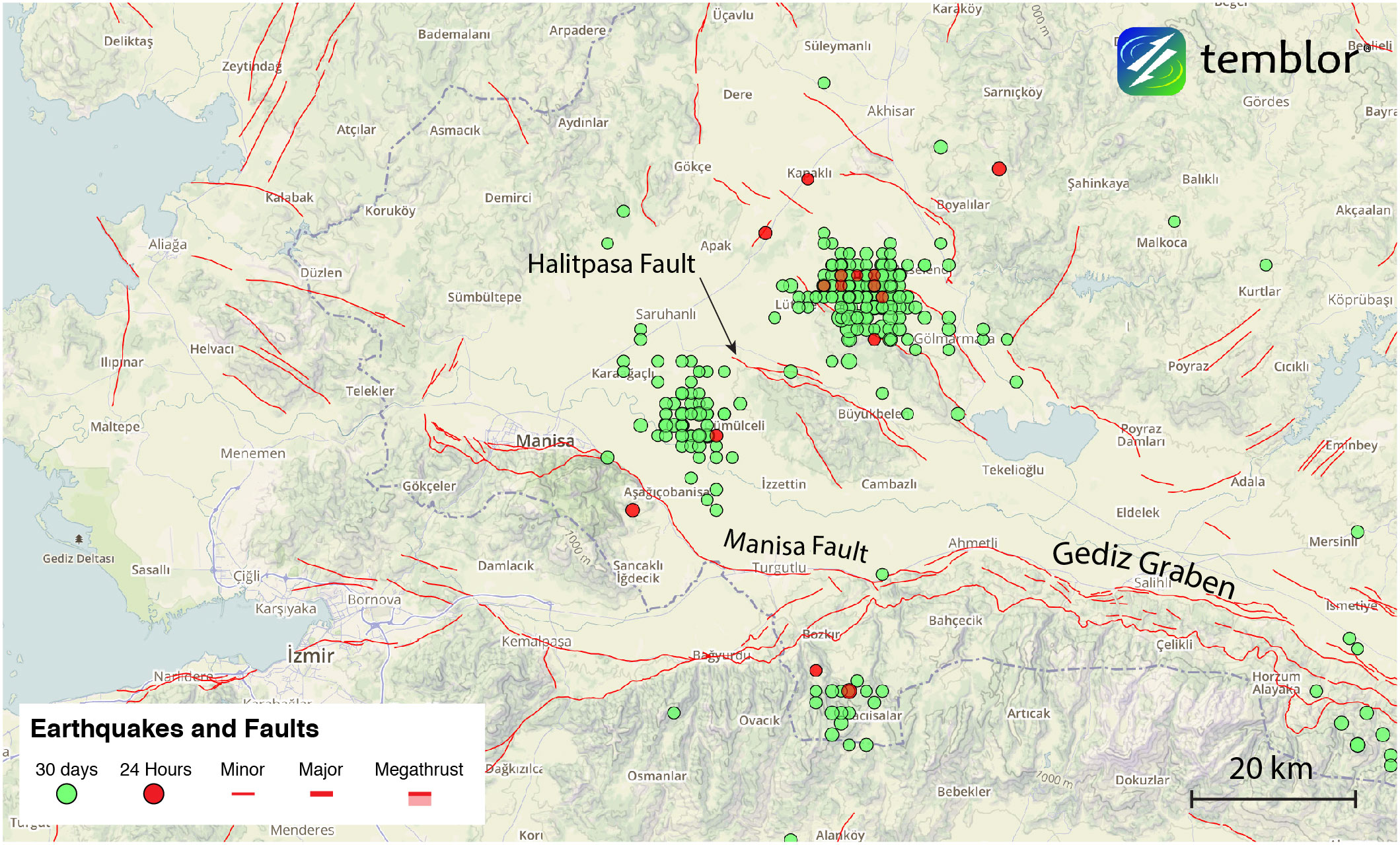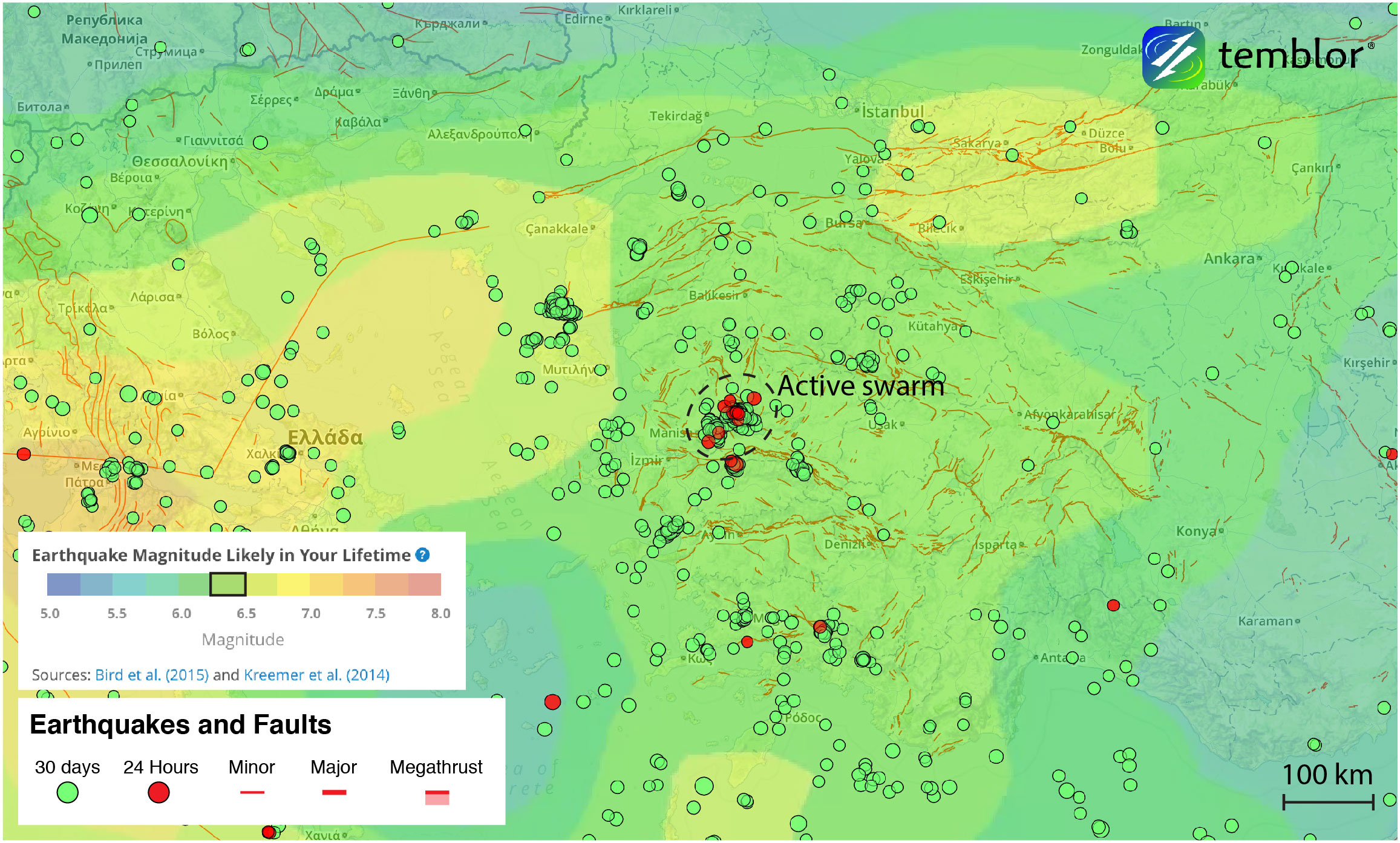By David Jacobson, Temblor

Over the last 5 days, there has been a seismic swarm in progress in Western Turkey near the city of Izmir, on the Aegean Sea, which has a population of close to 3 million people. This swarm began on Saturday, and the largest quake was a M=5.0 at a depth of 13 km. The next day, there was another M=5.0 about 5 km to the northwest. In total, there have been approximately 250 earthquakes in this region since the swarm began. All of these appear to be extensional faulting events. Fortunately, none of these quakes have been large enough to cause damage. However, they are close to a major fault system, which runs through two populated areas, that is capable of generating large magnitude earthquakes.

Western Turkey is an area of active continental extension, and contains many east-west trending grabens. According to the USGS, a graben is a down-dropped block of the earth’s crust resulting from extension. What this means is that for the last 25 million years, Western Turkey has been experiencing north-south extension. Couple this with influence of the African plate subducting beneath the Anatolian plate, and you have a recipe for significant seismic activity.

In the area around the ongoing swarm, normal faults associated with the Gediz Graben dominate. Based on the locations of the earthquakes in the map above, it is possible that the smaller swarm to the southwest occurred on the Manisa Fault, a 50 km-long normal fault that is subsidiary to the Gediz Graben. However, for this to be the case, the Manisa Fault would have to be dipping at an extremely low angle. While there are papers suggesting the Manisa Fault is low angle, based on the depth of these shocks, we believe that this smaller swarm occurred on a secondary, unmapped structure associated with this major fault.
In contrast, the larger swarm to the northeast appears to have occurred on the Halitpasa Fault, which is just to the west of Lake Marmara. This swarm is not only larger, but continues to be active, as there have been around 10 small quakes in the last 24 hours.
One of the reasons why swarms are important to highlight is because on occasion, they can be a precursor to larger events. While this may not happen here, pointing out an increase in seismic activity is essential, as even the smaller normal faults are capable of rupturing in M=6.0 earthquakes. Furthermore, the Gediz Graben in Western Turkey is capable of rupturing in M=7.0+ earthquakes, which could be devastating to the cities of Izmir or Manisa. Based on the Global Earthquake Activity Rate (GEAR) model, which is available in Temblor, a M=6.25 earthquake is likely in your lifetime for this area. What this means is that a large-scale rupture along the Gediz Graben would be a rare event, while a smaller shock on an associated structure is likely.

References
USGS
European Mediterranean Seismological Centre
Erdin Bozkurt & Hasan Sözbilir (2006) Evolution of the Large-scale Active Manisa Fault, Southwest Turkey: Implications on Fault Development and Regional Tectonics, Geodinamica Acta, 19:6, 427-453, DOI: 10.3166/ga.19.427-453
Xavier Le Pichon and Corne Kreemer, The Miocene-to-Present Kinematic Evolution of the Eastern Mediterranean and Middle East and Its Implications for Dynamics, Annu. Rev. Earth Planet. Sci. 2010. 38:323–51
- Earthquake science illuminates landslide behavior - June 13, 2025
- Destruction and Transformation: Lessons learned from the 2015 Gorkha, Nepal, earthquake - April 25, 2025
- Knock, knock, knocking on your door – the Julian earthquake in southern California issues reminder to be prepared - April 24, 2025
